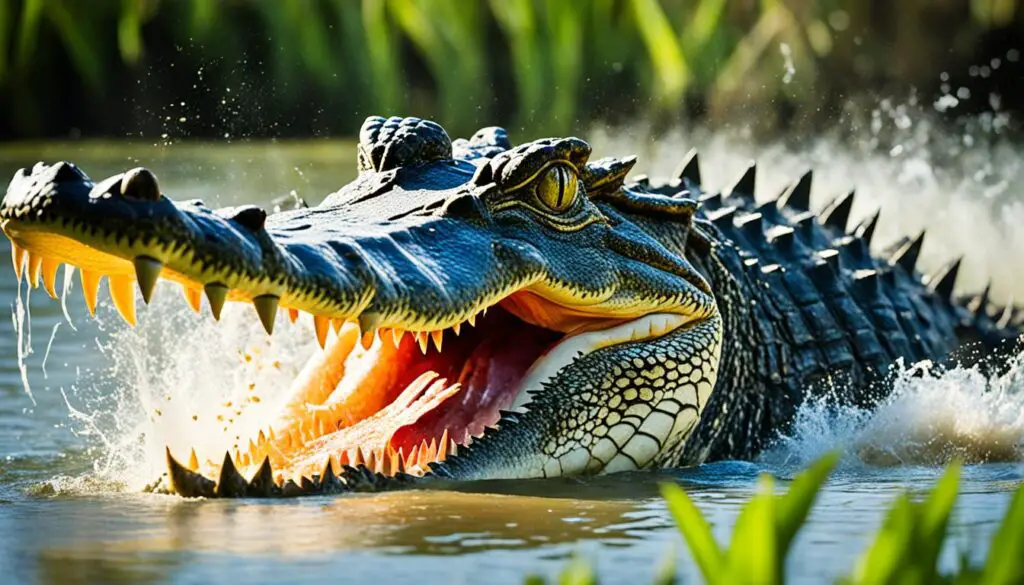Crocodiles are key predators in their semi-aquatic homes. They eat a wide variety of food, showing their adaptability. This adaptability helps them survive and keeps their ecosystems balanced. Let’s look at what these powerful reptiles eat and how it affects their behavior in the wild.
Understanding Crocodile Diets
Crocodile diets are interesting and varied, showing how they can adapt as predators. They mainly eat a wide range of prey, proving their carnivorous nature. These reptiles have amazing crocodile feeding habits that help them survive in different places by using many food sources at each life stage.
Overview of Crocodile Feeding Habits
The crocodile diet changes as they grow. Baby crocodiles start with small prey like insects, then move on to bigger animals like fish and birds. This shows how they adapt and survive in their homes. Learning about their crocodile feeding habits helps us see how they manage in different environments.
Carnivorous Nature of Crocodiles
The carnivorous nature of crocodiles makes them skilled hunters. They have strong jaws and special teeth for catching and eating flesh. They eat from small fish to big mammals, showing they are top predators. Some studies suggest that certain crocodiles might also eat fruit, showing they can be opportunistic with their crocodile diet.
| Age Group | Typical Prey | Feeding Strategy |
|---|---|---|
| Juvenile | Invertebrates, small fish | Active foraging |
| Sub-adult | Fish, amphibians | Ambush tactics |
| Adult | Large mammals, birds, other reptiles | Strategic hunting |
Crocodile Food Sources
Crocodiles are very adaptable in what they eat, showing a wide range of food sources based on their environment. This helps us understand how they survive and fit into their ecosystems.
Diverse Range of Prey
A crocodile’s diet is quite varied, making them top predators in their homes. They eat many animals, including:
- Fish
- Amphibians
- Birds
- Small mammals
- Other reptiles
Some species, like the Nile crocodile and the American alligator, also eat fruits. This shows how wide their diet can be. Eating a variety of foods is key for their health and survival in different places.
Impact of Habitat on Diet
The place where crocodiles live greatly affects what they eat. In freshwater spots like rivers and lakes, they find certain foods that fit their eating habits. But, saltwater crocodiles in the ocean eat different things because of their new environment.
Where they live changes what they mainly eat. This shows how important their habitat is in shaping their diet.
Types of Crocodile Prey
Crocodiles have a varied diet that shows how well they adapt as predators. They eat many different types of prey, using their environment to their benefit. Knowing what they eat helps us understand how they hunt and what they prefer to eat.
Common Prey Items Like Fish and Birds
Fish are a big part of what crocodiles eat because they live in the same places. Crocodiles catch fish quickly and quietly. They also eat birds, especially those near water, making their diet more varied.
This variety helps them survive in different places.
Large Mammals and Other Reptiles
When they can, crocodiles eat bigger animals like deer and wild pigs. They use sneaky attacks to catch these large mammals. They also eat smaller reptiles, showing how versatile they are as predators.

Behavioral Insights: Crocodile Hunting Patterns
Crocodiles have amazing hunting patterns that help them be top predators. They often use ambush hunting. They hide in the water, looking just like the surroundings. Then, they strike fast and catch their prey off guard.
This way, they greatly increase their chances of catching food. It shows how their hunting habits have changed over millions of years.
Ambush Hunting Techniques
To ambush hunt, crocodiles must be very still and hidden. They hide in reeds or underwater plants. When prey comes close, they move super fast to catch it off guard.
This method shows how well they’ve adapted to be at the top of the food chain.
Group Hunting vs. Solitary Approaches
Some crocodiles hunt alone, but others hunt in groups. Group hunting is good for catching big prey or when food is scarce. The way they hunt changes with the environment.
Big groups work together to take down their prey. This teamwork is key to their survival. It shows how both alone and together, they manage their hunting and what they eat.










